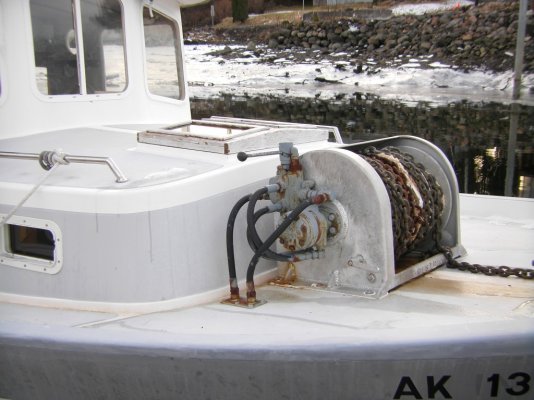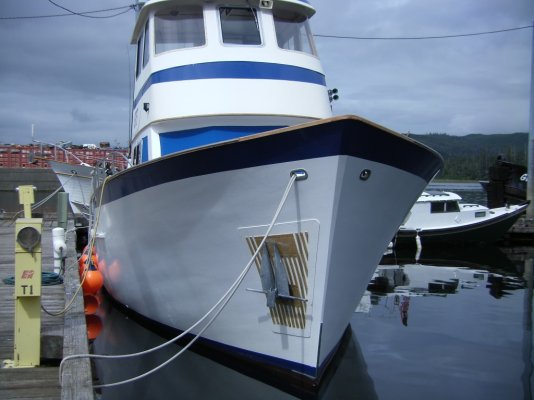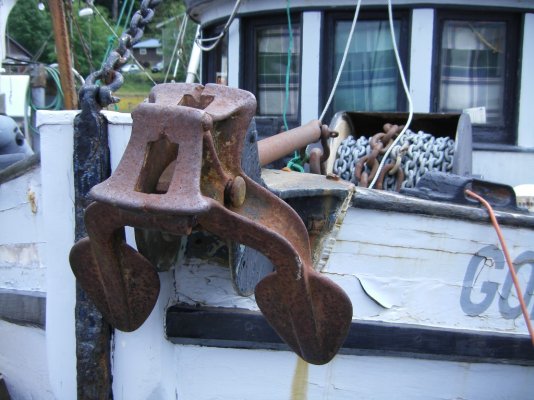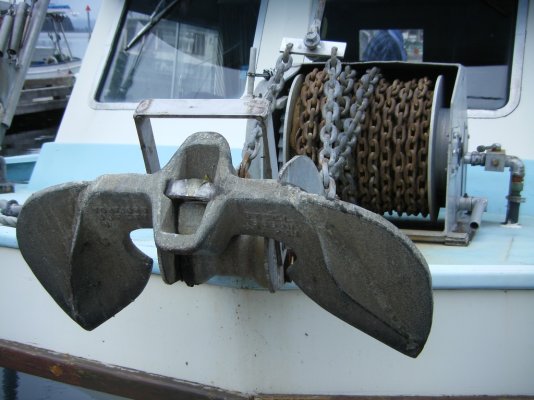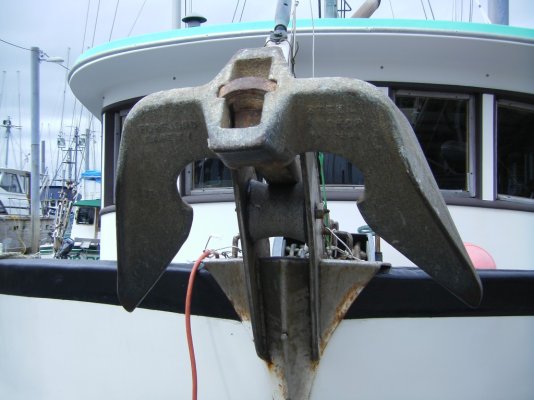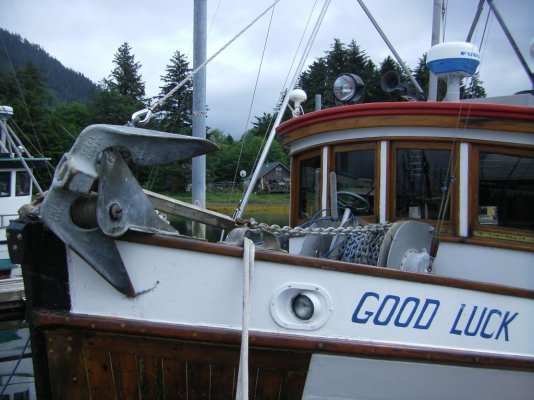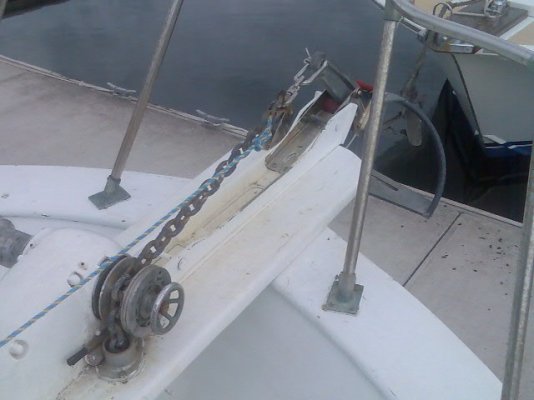nomadwilly wrote:I'm convinced these anchors won't set unless they are laying on their side and that lakes a bunch of scope AND chain to keep the shank down.
Well, anchors like the Manson Supreme, Rocna, Sarca, etc. are designed to set ONLY if they're lying on their sides, so their designs are such that when they land on the bottom they ALWAYS end up on their sides.* So they automatically position themselves in the proper attitude to pivot down like a knife blade and slice into the bottom.
But you're correct, they won't do this if you're pulling up on the shank, which is what you're doing with your super-short, no-chain rode.* But a Bruce or a CQR won't set either, if you're pulling up on the shank.* As Peter said, a Danforth-type of anchor MIGHT set when you pull back and up on the shank but if it does it will only be because it is on a very soft bottom--- mud or sand--- and it won't dig very deep.* So its "set" will keep you from drifting away in the current or a light breeze but in the event a decent wind comes up I will bet it won't stay set very long.
I think you're trying to force a square peg into a round hole with all this.* As I see it--- Chapman's or no Chapman's--- there are a very limited number of formulas that work in anchoring.* In what I think is the order of preference----
1.* An anchor sized for the boat with sufficient chain on the rode (or an all-chain rode) and sufficient scope to allow the anchor to perform as designed.
2.* An oversized anchor for your boat that MIGHT allow you to get away with a less-than-normal scope ratio IF you have sufficient chain (or all chain) at the end of the rode to hold the shank of the anchor down to allow it to perform as designed.
3.* An undersized anchor for your boat with a LOT of rode out with enough chain on the end of the rode to hold the shank of the anchor down and allow it to perform as advertised.
4.* A truly massive anchor with no weight on the end of the rode because the thing is so heavy it has enough weight of its own to set without the need for any additional weight on rode.
You're not doing any of those things.* You're trying to use an undersized anchor with a nylon rode with no weight (chain) on it at all, and you're trying to use a very short scope to set it with.* So you have created a formula that won't work, like the monks way back when who were convinced that with the right combination of herbs and prayer they could turn lead into gold.
You've given us some additional information that says that you're weight limit for hauling aboard by hand is about 20 pounds. Okay, that's a valid requirement.* So what you need to do is apply that requirement to the four conditions I listed above.* The only condition it remotely fits is (3).* But.... this won't work because you say in the places you want to anchor you have to use a very short scope.
The ONLY way to meet your 20 pound limit requirement is to supplement your pulling power so you can retrieve higher weights.* That means giving yourself a mechanical advantage of some sort, and that means a windlass.* Doesn't have to be electric or hydraulic or heavy or real expensive.* A simple manual windlass would work if the slow retrieval speed is not an issue.* But as soon as you insert a windlass into the mix, all four of the formulas will work for you.* Some better than others but you can do any of them.
Right now you've got a small collection of anchors---- if I remember right an XYZ, a Bruce, a Danforth, and a Manson Supreme--- and you're thinking of adding yet another one, a Fortress.* Your theory is that if you have enough types of anchors on your boat, one of them MIGHT set for you with your no-chain, short scope, nylon rode.* From your previous descriptions, all the anchors you have now are considerably undersized for your boat.* So anchoring for you is a matter of trying one anchor, then another one, and so on in an attempt to get something to work.
Most boaters have one anchor on their bows.* The types vary because of local conditions or what the boater believes is the best design.* A few boats that are large enough to accomodate them have two anchors on the bow, usually of two different types---- a Bruce and a Danforth or a Bruce and a CQR are the combinations I see most often in our marina.* But even then, both anchors and their rodes (if they each have their own rode) are sized to fit the proper formula for the boat.
But most of us have just one anchor up there and--- regardless of the type--- they* meet almost all the anchoring requirements each boater encounters.* Our anchors are sized to hold our boats in the worst "normal" conditions we're likely to encounter and they have sufficient weight in or at the end of the rode to enable the anchor to work as designed.* Very few of us have the physical wherewithal to haul these arragements up by hand every time we anchor.* I pulled up our 44# Rocna with all-chain rode by hand once when our original windlass packed it in, but while I could do it I woudn't want to make a habit of it.
So most of us have a windlass of some sort so we can use the proper combination of anchor size and rode type, size, and weight that will hold our boats.*
That's the formula that works.
Friends we boated with had a 30' Newport sloop.* They had a Bruce anchor--- I think it was about a 22-pounder--- and a nylon-chain rode.* They didn't anchor a lot, but when they did it was no real problem for the husband to haul the anchor by hand.* Then three years ago they decided to take a five-month cruise to SE Alaska.* They knew they'd be anchoring in deeper waters, and they'd be anchoring a lot.* So they installed a windlass on their boat and I believe also added a lot more chain to the end of their rode.* This helped their anchor set faster and better and when they were over the anchor during the retrieve there would be chain up at windlass wildcat.* And as I recall they had no anchoring problems the entire trip.* Deep water, tiny bays, whatever,* they had the means of dealing with it and making their correctly sized anchor work for them every time.
So if I was you, my solution to the "small anchorages, deep water" problem would be to buy an oversize anchor for my 30' Willard--- probably a Rocna knowing what I know now but other anchor types will work fine, too--- a 250' nylon rode (since my 30' Willard may not be happy with a lot of weight in the bow), and perhaps 60 feet of correctly sized chain, probably 3/8" given the fact I got an oversize anchor that is probably in the 40-pound range.* Then I would buy a windlass to haul this stuff up.
And don't waste your time and money on 1/4" chain.* The whole idea behind anchoring is to stay where you are, not stay where your are IF the lightweight stuff you're messing around with happens to hold together.
-- Edited by Marin on Friday 23rd of July 2010 12:41:39 PM
